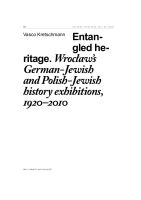Entangled heritage. Wrocławs’s German-Jewish and Polish-Jewish history exhibitions, 1920-2010
Author(s)
Publication Name
Publication Date
Abstract
This paper examines how the museums of German Breslau and Polish Wrocław have dealt with the city’s Jewish past over the last century. The history presentations stand symbolically for the integration as well as the exclusion of a significant part of Wrocław’s population. Jewish history exhibitions reflect in particular the discontinuity of popular culture in the 20th century. In 1928/29 the City Museum of Breslau supported the community in establishing a Jewish Museum. After 1933 the exclusion of Jews from public life was drastic, a separate Jewish museum existed until the pogrom of 1938 and the destruction of the Jewish community. On the ruins of German-Jewish Breslau grew Polish- Jewish Wrocław. Significant here is how different aspects and places of German- and Polish- Jewish heritage have been interwoven. After only a few years this large Jewish-Polish community was excluded by the communist nation state. Jewish history was banned from the public museums of Wrocław until the 1980s. Here the renovation of the Old Jewish Cemetery was a major step in discovering and exhibiting the Jewish past. It was an expression of the restitution of a crucial chapter of local history that went beyond national limitations.
Topics
Genre
Geographic Coverage
Original Language
Volume/Issue
51(1)
Page Number / Article Number
92-103
DOI
Link
Bibliographic Information
Entangled heritage. Wrocławs’s German-Jewish and Polish-Jewish history exhibitions, 1920-2010. 2017: 92-103. https://archive.jpr.org.uk/10.5604/01.3001.0010.4078





